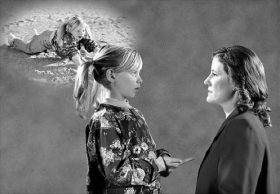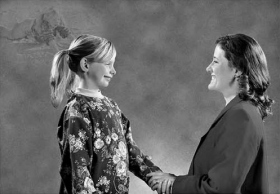This section provides many techniques for a parent or anyone to use to help a child recover rapidly from the bumps, bruises, scrapes, scares and upsets that are often part of growing up.
For the most part, the techniques which follow utilize
The actions described below all classify as assists. An assist is an action undertaken to help an individual obtain relief from an immediate troublesome difficulty. These assists should be used in addition to those in the “Assists for Illnesses and Injuries” course whenever circumstances require. The benefits for the child and the family can be considerable.
Childhood Injuries
There are many things one can do to aid a child who suffers a minor fall, cut or the like. In young children, often just letting them cry out seems to be enough. When a child is hurt, most people find themselves speaking comforting and consoling words almost before they know it. And what they say is usually what they have said a hundred times before when the child was hurt. This can remind the child of the whole chain of earlier injuries.
Parents can help a child most by saying nothing. It may take a short while to train themselves not to speak when the child is hurt, but it is not difficult to form the habit of remaining silent. Silence need not inhibit affection. One may hold the child, if he wants to be held, or put an arm around him. Often, if nothing is said, a young child will cry hard for a minute or so, and then suddenly stop, smile, and run back to what he was doing. Allowing him to cry seems to release the tension resulting from the injury and no assist is needed if this occurs. In fact, it is often very difficult to make the child return to the moment of injury if he has released the tension this way.
“Tell Me About It”
If the child does not spontaneously recover after a moment or two of crying, then wait until he has recovered from the short period of lowered awareness that accompanies an injury. It is usually not difficult to tell when a child is dazed and when he is not. If he still cries after the dazed period, it is usually because other previous injuries have been restimulated (reactivated due to similar circumstances in the present approximating circumstances of the past). In this case, an assist is valuable. On older children (age five and up) an assist is usually necessary.
When the child is no longer dazed, ask him, “What happened? How did you get hurt? Tell me about it.”
As he begins to tell about it, switch him to the present tense if he doesn’t tell the story in the present tense spontaneously. Try it this way:
“Well—I was standing on a big rock and I slipped and fell, and...” (crying)
“Does it hurt when you are standing on the rock?”
“No.”
“What happens when you are standing on the rock?”
“I slip...” (crying)
“Then what happens?”
“I fall on the ground.”
“Is there grass on the ground?”
“No—it’s all sandy.”
“Tell me about it again.”
You can take the child through it several times until he gets bored or laughs. There is nothing difficult about it. After a child has had a few assists this way, he will, upon being injured, run to the person who can administer this painless help and reassurance, demanding to “tell about it.”
an interchange of ideas across space between two individuals.



